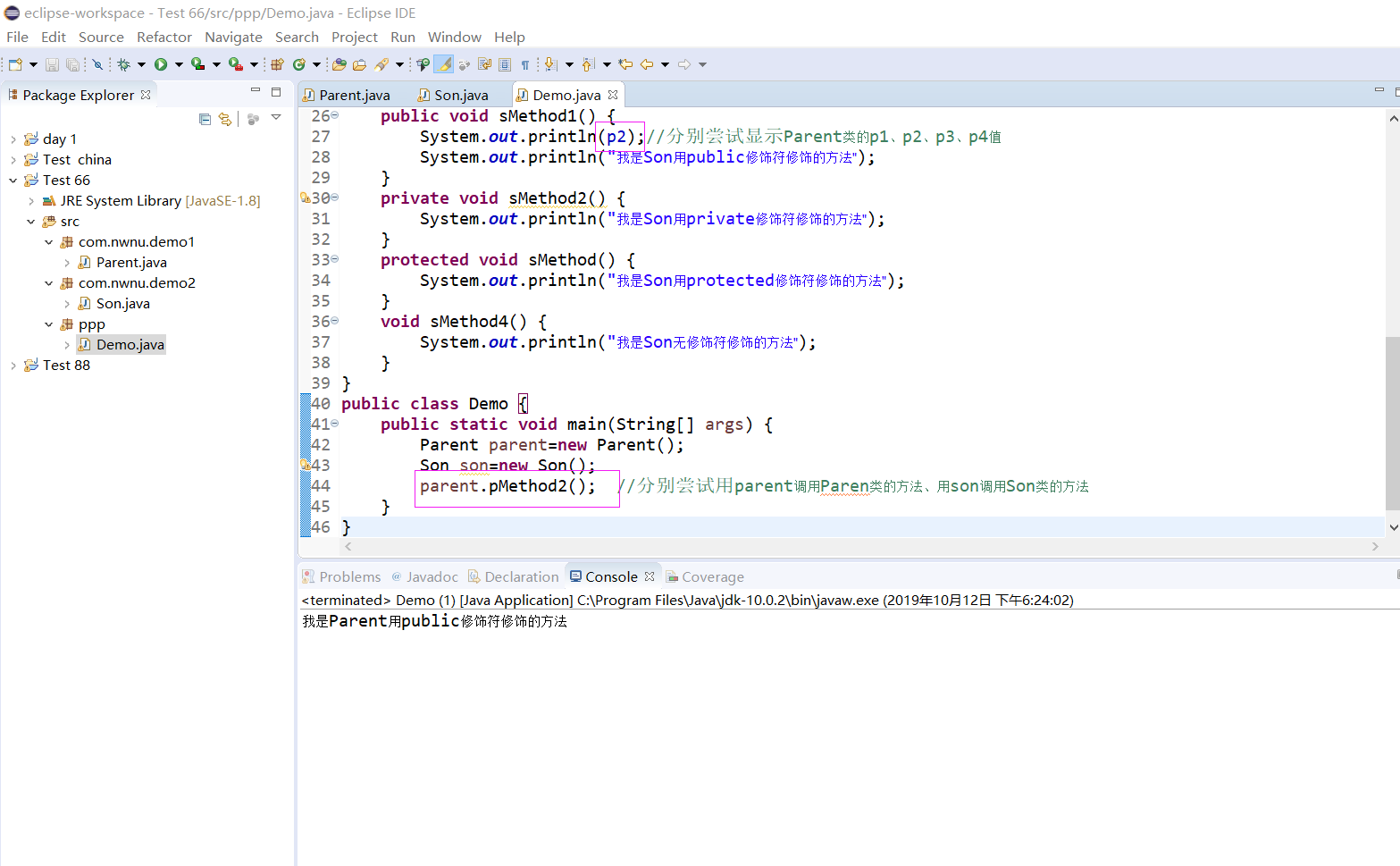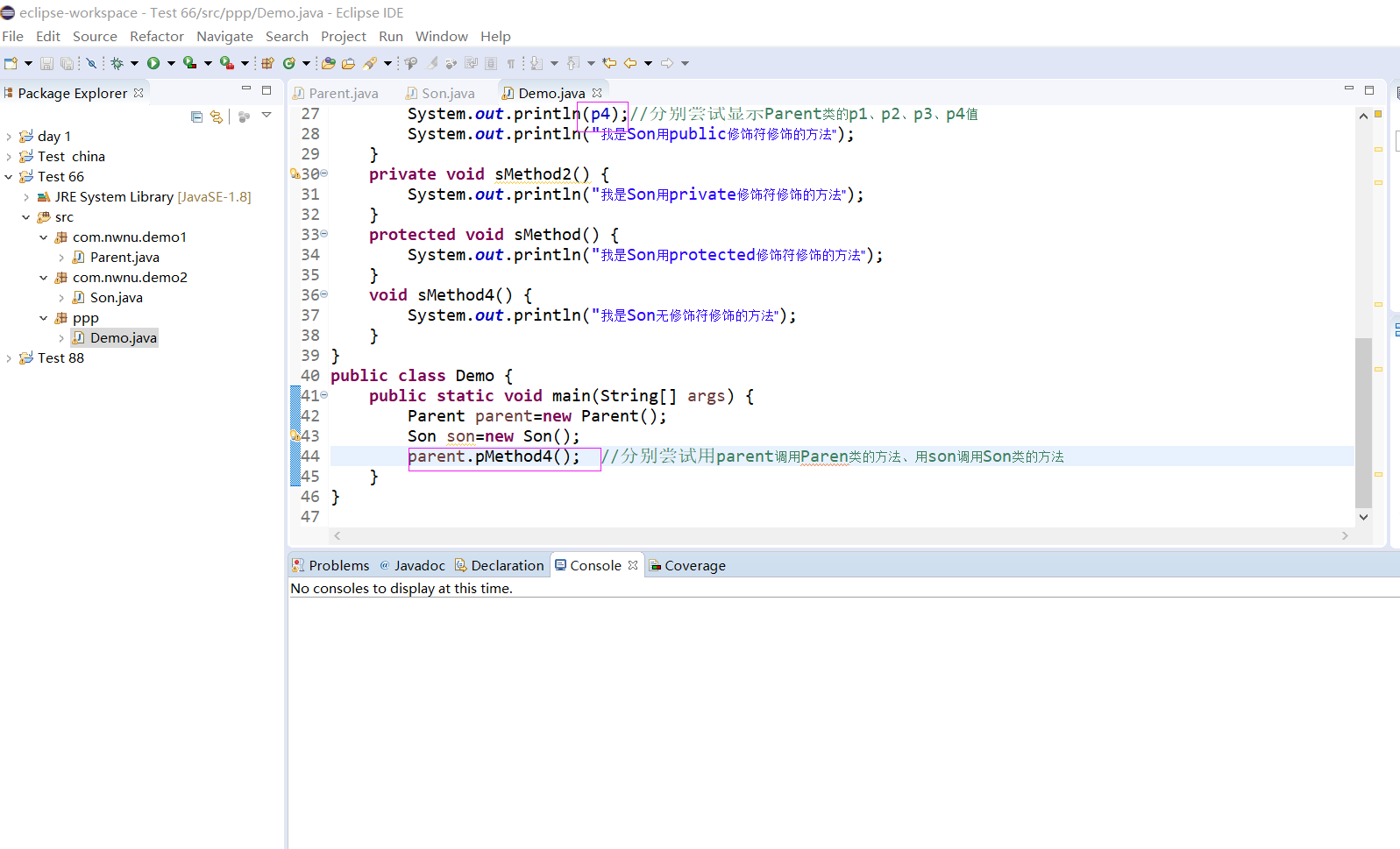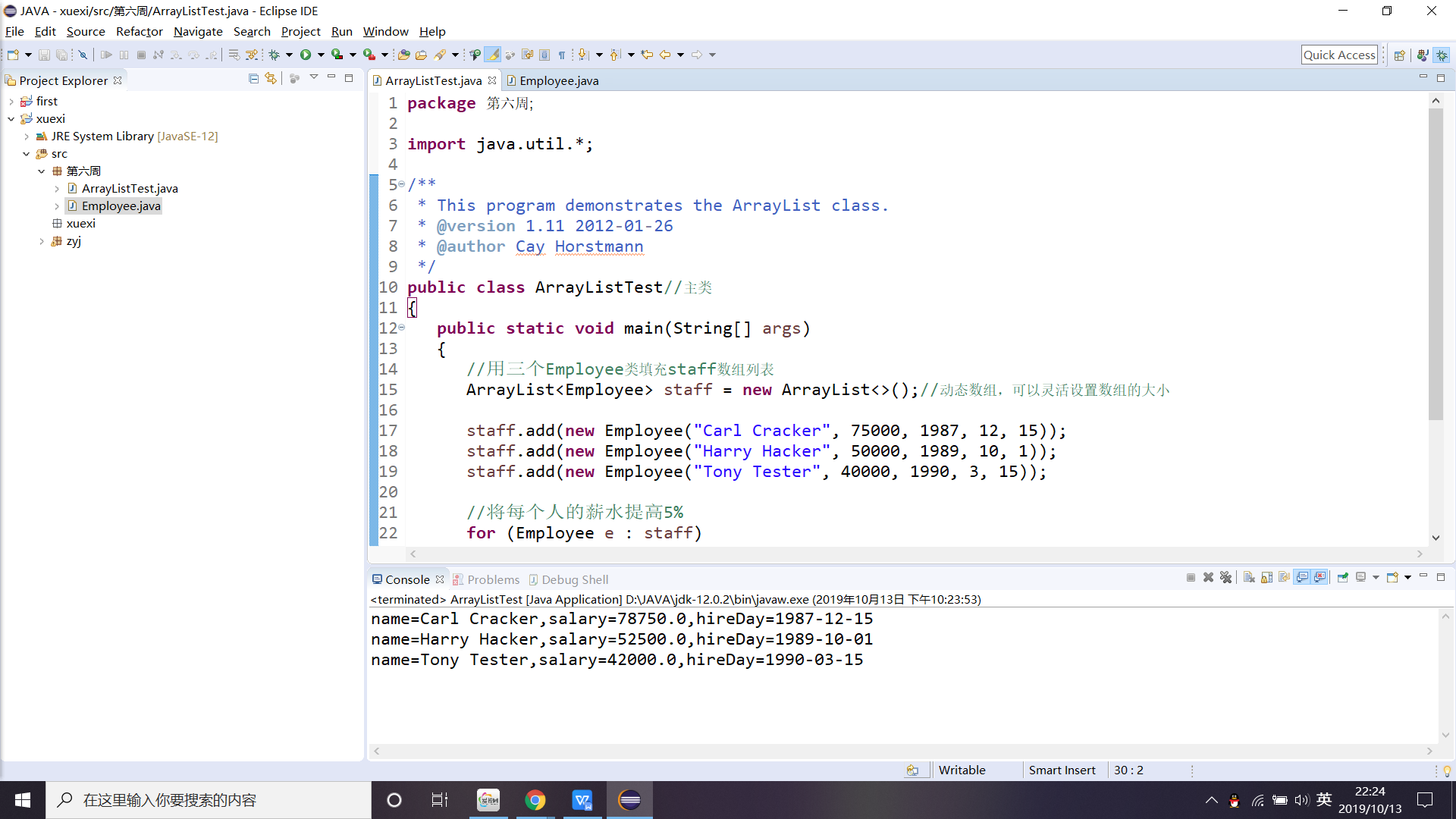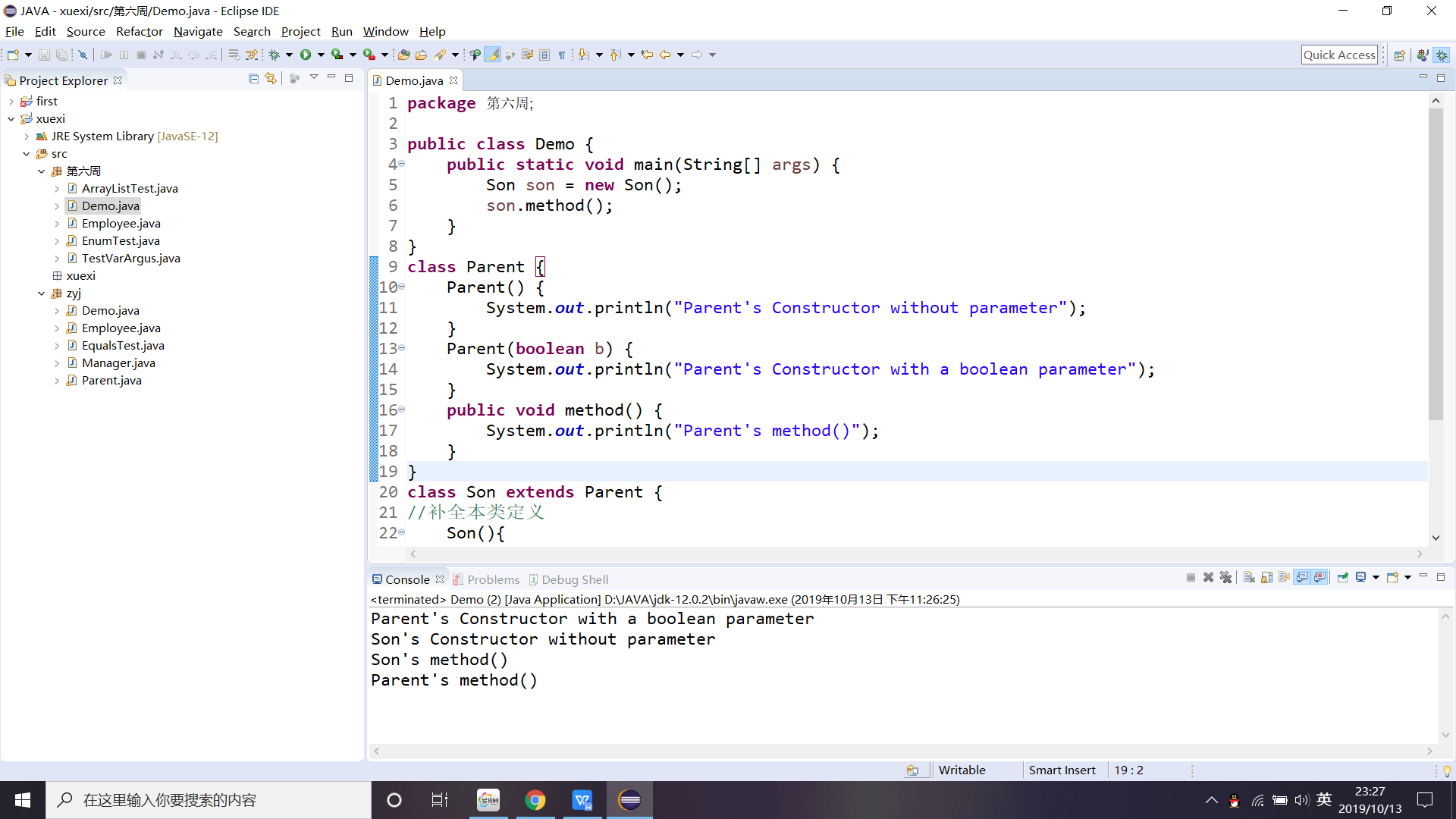|
项目 |
内容 |
|
这个作业属于哪个课程 |
https://www.cnblogs.com/nwnu-daizh/ |
|
这个作业的要求在哪里 |
https://www.cnblogs.com/nwnu-daizh/p/11435127.html |
|
作业学习目标 |
|
实验内容和步骤
实验1:在“System.out.println(...);”语句处按注释要求设计代码替换...,观察代码录入中IDE提示,以验证四种权限修饰符的用法。(20分)
代码如下:
package project;
class Parent {
private String p1 = "这是Parent的私有属性";
public String p2 = "这是Parent的公有属性";
protected String p3 = "这是Parent受保护的属性";
String p4 = "这是Parent的默认属性";
private void pMethod1() {
System.out.println("我是Parent用private修饰符修饰的方法");
}
public void pMethod2() {
System.out.println("我是Parent用public修饰符修饰的方法");
}
protected void pMethod3() {
System.out.println("我是Parent用protected修饰符修饰的方法");
}
void pMethod4() {
System.out.println("我是Parent无修饰符修饰的方法");
}
}
class Son extends Parent{
private String s1 = "这是Son的私有属性";
public String s2 = "这是Son的公有属性";
protected String s3 = "这是Son受保护的属性";
String s4 = "这是Son的默认属性";
public void sMethod1() {
System.out.println(p2);//分别尝试显示Parent类的p1、p2、p3、p4值
System.out.println("我是Son用public修饰符修饰的方法");
}
private void sMethod2() {
System.out.println("我是Son用private修饰符修饰的方法");
}
protected void sMethod() {
System.out.println("我是Son用protected修饰符修饰的方法");
}
void sMethod4() {
System.out.println("我是Son无修饰符修饰的方法");
}
}
public class Demo {
public static void main(String[] args) {
Parent parent=new Parent();
Son son=new Son();
System.out.println(parent.p2);
System.out.println(parent.p3);
System.out.println(parent.p4);//分别尝试用parent调用Paren类的方法、用son调用Son类的方法
System.out.println(son.p2);
System.out.println(son.p3);
System.out.println(son.p4);
System.out.println(son.s2);
System.out.println(son.s3);
System.out.println(son.s4);
parent.pMethod2();
son.pMethod2();
son.sMethod1();
}
}
该代码是将子类父类以及主函数放在同一个包的同一个文件中,其除了parent类的private不可调用外,其他三个类都可以。子类除了不可以调用父类的私有域外,同样可以调用父类的其他域和方法
。
运行结果如下:
调用p2以及方法2得到的结果:

调用方法3得到的结果:

调用方法4得到的结果:

四种权限修饰符的访问范围的情况:
| 访问范围 | private | friendly(默认) | protected | public |
| 同一个类 | 可以访问 | 可以访问 | 可以访问 | 可以访问 |
| 同一个包内的类 | 不可以访问 | 可以访问 | 可以访问 | 可以访问 |
| 不同包内的类 | 不可以访问 | 不可以访问 | 可以访问 |
可以访问 |
| 不同包并且不是子类 | 不可以访问 | 不可以访问 | 不可以访问 | 可以访问 |
protected介于public和private之间,只能被类本身的方法和子类访问,即使子类在不同的包中也可以访问。
默认访问的这种修饰符,只能被在同一个包中的类访问和引用,而不能被其他包中的类使用,即使其他包中有该类的子类。
实验2:导入第5章以下示例程序,测试并进行代码注释。
测试程序1:
a)运行教材程序5-8、5-9、5-10,结合程序运行结果理解程序(教材174页-177页);
b) 删除程序中Employee类、Manager类中的equals()、hasCode()、toString()方法,背录删除方法,在代码录入中理解类中重写Object父类方法的技术要点。
Employee类代码如下:
package equals;
import java.time.*;
import java.util.Objects;
public class Employee
{
private String name; //实例域定义
private double salary;
private LocalDate hireDay;
public Employee(String name, double salary, int year, int month, int day)//构造器定义
{
this.name = name;
this.salary = salary;
hireDay = LocalDate.of(year, month, day);
}
public String getName()
{
return name;
}
public double getSalary()
{
return salary;
}
public LocalDate getHireDay()
{
return hireDay;
}
public void raiseSalary(double byPercent)
{
double raise = salary * byPercent / 100;
salary += raise;
}
public boolean equals(Object otherObject)
{
// 快速检查对象是否相同
//这里获得一个对象参数,第一个if语句判断两个引用是否是同一个,如果是那么这两个对象肯定相等
if (this == otherObject) return true;
// 如果显式参数为空,则必须返回false
if (otherObject == null) return false;
// getClass()方法是得到对象的类,如果两个对象的类不一样,那么就不相等
if (getClass() != otherObject.getClass()) return false;
//现在我们知道另一个对象是非空雇员
//在以上判断完成,再将得到的参数对象强制转换为该对象,考虑到父类引用子类的对象的出现,然后再判断对象的属性是否相同
var other = (Employee) otherObject;
//测试字段是否具有相同的值
return Objects.equals(name, other.name)
&& salary == other.salary && Objects.equals(hireDay, other.hireDay);
}
public int hashCode()
// 哈希散列
{
return Objects.hash(name, salary, hireDay);
}
// toString()方法,可自动生成
public String toString()
{
return getClass().getName() + "[name=" + name + ",salary=" + salary + ",hireDay="
+ hireDay + "]";
}
}
EqualsTest类代码如下:
package equals;
/**
* This program demonstrates the equals method.
* @version 1.12 2012-01-26
* @author Cay Horstmann
*/
public class EqualsTest
{
public static void main(String[] args)
{
var alice1 = new Employee("Alice Adams", 75000, 1987, 12, 15); //创建对象,并初始化
var alice2 = alice1;
var alice3 = new Employee("Alice Adams", 75000, 1987, 12, 15);
var bob = new Employee("Bob Brandson", 50000, 1989, 10, 1);
System.out.println("alice1 == alice2: " + (alice1 == alice2));
System.out.println("alice1 == alice3: " + (alice1 == alice3));
System.out.println("alice1.equals(alice3): " + alice1.equals(alice3));
System.out.println("alice1.equals(bob): " + alice1.equals(bob));
System.out.println("bob.toString(): " + bob);
var carl = new Manager("Carl Cracker", 80000, 1987, 12, 15);
var boss = new Manager("Carl Cracker", 80000, 1987, 12, 15);
boss.setBonus(5000);
System.out.println("boss.toString(): " + boss);
System.out.println("carl.equals(boss): " + carl.equals(boss));
System.out.println("alice1.hashCode(): " + alice1.hashCode());
System.out.println("alice3.hashCode(): " + alice3.hashCode());
System.out.println("bob.hashCode(): " + bob.hashCode());
System.out.println("carl.hashCode(): " + carl.hashCode());
}
}
Manager类代码如下:
package equals;
public class Manager extends Employee
{
private double bonus;
public Manager(String name, double salary, int year, int month, int day)
{
super(name, salary, year, month, day);
bonus = 0;
}
public double getSalary()
{
double baseSalary = super.getSalary();
return baseSalary + bonus;
}
public void setBonus(double bonus)
{
this.bonus = bonus;
}
public boolean equals(Object otherObject)
{
if (!super.equals(otherObject)) return false;
var other = (Manager) otherObject;
//检查这个和其他属于同一个类
return bonus == other.bonus;
}
public int hashCode()
{
return java.util.Objects.hash(super.hashCode(), bonus);
}
public String toString()
{
return super.toString() + "[bonus=" + bonus + "]";
}
}
其运行结果如下:

1、equals方法:
Object类中的equals方法用于检测某个对象是否同另一个对象相等。它在Object类中的实现是判断两个对象是否相等的引用。如果两个对象具有相同的引用,它们一定是相等的;
如果需要检测两个对象状态的相等性,就需要在新类的定义中需要覆盖equals方法;
定义子类的equals方法时,可调用超累的equals方法;
super. equals (otherObjecct)
2、hashCode方法:
Object类中的哈hashCode方法导出某个对象的散列码。散列码时任意整数,表示dui过的存储地址;
两个相等对象的散列码相等。
3、toString方法:
Object类中的toString方法返回一个代表该类对象域值的字符串;
定义子类的toString方法时,可先调用超类的toString方法;
super.toString()
toString方法是非常重要的调试工具。标准类库中,多数类定义了toString方法,以便用户获得对象状态的必要信息。
测试程序2:
a) 在elipse IDE中调试运行程序5-11(教材182页),结合程序运行结果理解程序;
b) 掌握ArrayList类的定义及用法;
c) 在程序中相关代码处添加新知识的注释;
e)设计适当的代码,测试ArrayList类的set()、get()、remove()、size()等方法的用法。
程序代码如下:
package arrayList;
import java.util.*;/** * This program demonstrates the ArrayList class. * @version 1.11 2012-01-26 * @author Cay Horstmann */public class ArrayListTest{ public static void main(String[] args) { // fill the staff array list with three Employee objects ArrayList<Employee> staff = new ArrayList<Employee>(); //用三个Employee对象填充数组 staff.add(new Employee("Carl Cracker", 75000, 1987, 12, 15)); staff.add(new Employee("Harry Hacker", 50000, 1989, 10, 1)); staff.add(new Employee("Tony Tester", 40000, 1990, 3, 15)); // raise everyone's salary by 5% for (Employee e : staff) //把每个人的薪资提高%5 e.raiseSalary(5); // print out information about all Employee objects for (Employee e : staff) //输出所有雇员对象的信息 System.out.println("name=" + e.getName() + ",salary=" + e.getSalary() + ",hireDay=" + e.getHireDay()); //利用getName(),getSalary() 和getHireDay()方法输出所有雇员对象的信息 }}package arrayList;
import java.time.*;
public class Employee
{
private String name;
private double salary;
private LocalDate hireDay;
public Employee(String name, double salary, int year, int month, int day)
{
this.name = name;
this.salary = salary;
hireDay = LocalDate.of(year, month, day);
}
public String getName()
{
return name;
}
public double getSalary()
{
return salary;
}
public LocalDate getHireDay()
{
return hireDay;
}
public void raiseSalary(double byPercent)
{
double raise = salary * byPercent / 100;
salary += raise;
}
}
运行结果如下:

ArrayList 即动态数组,它可以动态的增加和减少元素,灵活设置数组的大小。
ArrayList提供了三个构造器:
public ArrayList(); 默认的构造器
public ArrayList(ICollection);
public ArrayList(int); 用指定的大小来初始化内部的数组
测试程序3:
a) 编辑、编译、调试运行程序5-12(教材189页),结合运行结果理解程序;
b)掌握枚举类的定义及用法;
c)在程序中相关代码处添加新知识的注释;
d)删除程序中Size枚举类,背录删除代码,在代码录入中掌握枚举类的定义要求。
程序代码如下:
import java.util.*;
/**
* This program demonstrates enumerated types.
* @version 1.0 2004-05-24
* @author Cay Horstmann
*/
public class EnumTest//主类
{
public static void main(String[] args)
{
Scanner in = new Scanner(System.in);
System.out.print("Enter a size: (SMALL, MEDIUM, LARGE, EXTRA_LARGE) ");
String input = in.next().toUpperCase();//字符串转换为大写
Size size = Enum.valueOf(Size.class, input);
System.out.println("size=" + size);
System.out.println("abbreviation=" + size.getAbbreviation());
if (size == Size.EXTRA_LARGE)
System.out.println("Good job--you paid attention to the _.");
}
}
enum Size//枚举类型(都是enum的子类)
{
SMALL("S"), MEDIUM("M"), LARGE("L"), EXTRA_LARGE("XL");//传入参数
private Size(String abbreviation) { this.abbreviation = abbreviation; }
public String getAbbreviation() { return abbreviation; }
private String abbreviation;
}

测试程序4:录入以下代码,结合程序运行结果了解方法的可变参数用法
public class TestVarArgus {
public static void dealArray(int... intArray){
for (int i : intArray)
System.out.print(i +" ");
System.out.println();
}
public static void main(String args[]){
dealArray();
dealArray(1);
dealArray(1, 2, 3);
}
}
程序运行结果如下:

实验:3:编程练习:参照输出样例补全程序,使程序输出结果与输出样例一致。
public class Demo {
public static void main(String[] args) {
Son son = new Son();
son.method();
}
}
class Parent {
Parent() {
System.out.println("Parent's Constructor without parameter");
}
Parent(boolean b) {
System.out.println("Parent's Constructor with a boolean parameter");
}
public void method() {
System.out.println("Parent's method()");
}
}
class Son extends Parent {
//补全本类定义
}
要求输出样式如下:
Parent's Constructor with a boolean parameter Son's Constructor without parameter Son's method() Parent's method()
实验代码:
public class Demo {
public static void main(String[] args) {
Son son = new Son();
son.method();
}
}
class Parent {
Parent() {
System.out.println("Parent's Constructor without parameter");
}
Parent(boolean b) {
System.out.println("Parent's Constructor with a boolean parameter");
}
public void method() {
System.out.println("Parent's method()");
}
}
class Son extends Parent {
//补全本类定义
Son(){
super(false);
System.out.println("Son's Constructor without parameter");
}
public void method() {
System.out.println("Son's method()");
super.method();
}
}
程序运行结果如下:

二、实验总结
通过本周的实验,我掌握理解了成员访问权限的四个修饰符,Object类和ArrayList类的常用方法,API以及枚举使用方法。在写程序的过程中,我发现了我的不足,编程能力还远远不行。在继承学习中,仍有一些父类和子类的关系没搞懂;继承程序构造技术还不太熟练,需要继续学习巩固。